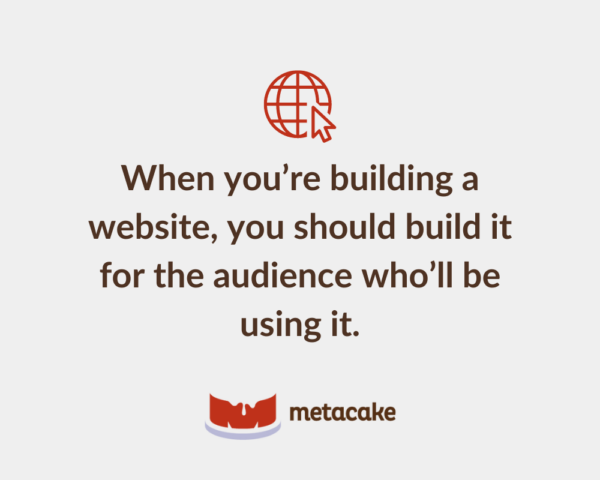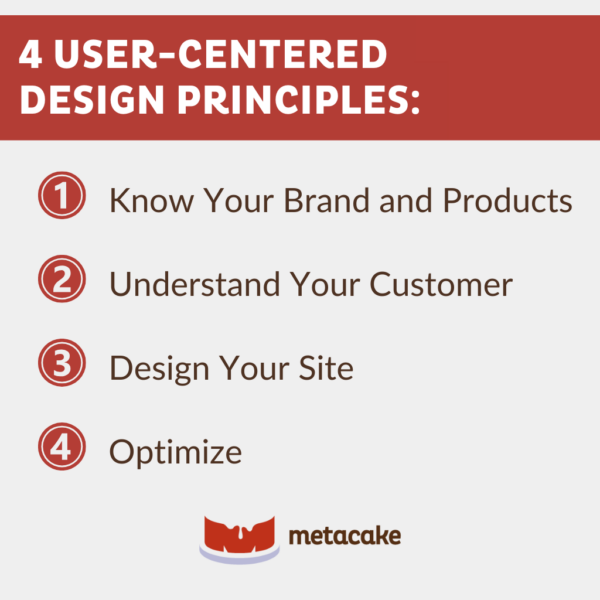As an ecommerce business owner, do you know who you’re building your website for?
It seems obvious, right? When you’re building a website, you should build it for the audience who’ll be using it.
Often, when a business is approaching a new website, they build it with themselves in mind, not their customers.

This is the wrong approach.
As a business owner, if you approach web design in terms of what you perceive as necessary information, what visual look and feel you like, and how you organize products internally, you’re doing it wrong!
Unless, of course, you’re trying to sell your products to yourself. In that case, rock on! For the rest of you, read on to learn some valuable insights into user-centered design principles and why they should matter to you.

User-Centered Design Principles
User-centered design (UCD) is a design philosophy and approach in which the needs and wants of end users of a product or service are carefully considered at each stage of the design process.
UCD can be defined as a multi-stage problem-solving process in which designers must not only evaluate and predict how customers will use a product but also test the validity of their assumptions about user behavior in real-world tests with actual users.
Let’s look at four principles of user-centered design.
1) Know Your Brand and Products
It’s important to have a deep understanding of your brand, your products, and how they connect with your customers. Knowing your brand means finding and understanding your identity and your story.
- Know who you are as a business.
- Know the story behind your existence.
- Know what your brand says.
- Know what your values are.
- Know what you want people to feel when they interact with your brand.
Knowing your product allows you to tweak your language and strategy to align with your customer’s values and expectations. Plus, it’s a vital component for customer service.
When thinking about your products, ask yourself:
- What is your product?
- What does it do?
- What solution or benefit does it offer the person who buys it?
- Why do people need your product?
- Why is your product superior to similar products?
2) Understand Your Customer
Customers are the heart of any business. After all, without customers to buy your products, there’d be no need to make them.
When you truly understand your customers, you can provide them with the type of product or service they expect. When their expectations are met — or, better yet, exceeded — they reciprocate by leaving positive feedback or referring other potential customers.
In the process of understanding your customer, ask yourself:
- How do they shop?
- How do they interact with brands, both online and offline?
- How exactly do they interact with your brand?
Your website design and marketing channels will vary greatly depending on your target customers’ demographics and behaviors.
Your customers are used to shopping in a certain way. Learn about their shopping habits and ensure that your website design reflects this.
3) Design Your Site
When it comes to designing the perfect experience for your customers, you won’t get it exactly right on your first attempt. However, if you have a thorough understanding of your brand and your customers, it’ll be a great start.
When building a website, you can attempt to build it yourself using a theme or website builder, or you can hire an expert to walk you through the process.
If you’re just starting out and have a small budget, it’s probably best to build it yourself. If your business is more mature and you have resources to invest, hiring a team will give you the best long-term outcome and allow you and your team to stay focused on your business.
4) Optimize
Once you launch your first attempt at a user-centered site, immediately start testing with actual users so you can continually improve your site.
- Listen to customer feedback.
- Conduct A/B testing.
- Monitor how your customers interact with your site.
- Revise it over time.
Base your tests on your analytics and where you have identified areas of opportunity. Then implement a test with a few different variations of ways you can improve performance.
Finally, let your customers provide you with the answer. Determine which option works best and implement it.
How Do You Get This User Info?
There are two types of information to gather from your users: quantitative and qualitative.
Quantitative information can be gathered through analytics platforms like Google Analytics as well as through your testing platform (Optimizely, for example). If you know how to read this data, it allows you to identify problem areas of your site as well as trends.
Qualitative information, on the other hand, can be gathered proactively through asking (via surveys or on-site polls) or passively (by watching responses to offers and promotions).
Here are some methods we recommend using to gather this information:
- Test price sensitivity with offers and promotions. This’ll help you identify what the barriers are to potential customers making a purchase.
- Use on-site polls. Request information from your site visitors via a short poll after a user has completed a specific action or sequence.
- Send out emails requesting reviews and questionnaires. Ask loyal customers for their feedback and input.
- Set up exit-intent popups. These can provide great insight into why customers are leaving your site and what they were looking for that they didn’t find.
User-Centered Design: Final Thoughts
Whether you plan to build your own site or collaborate with an ecommerce team to create a site that’s optimized for success, keep in mind that a site designed for the user provides exactly what they’re looking for.
A user-centered site allows customers to connect emotionally with your brand while still being practical in the way they prefer to purchase. It makes it easier to convert these customers by removing as many entry obstacles as possible. Plus, it keeps them coming back for more.
If your ecommerce business is planning to build a website adopting these user-centered design principles and you need help, we’re here for you. Our award-winning team is ready to assist you on this journey.
